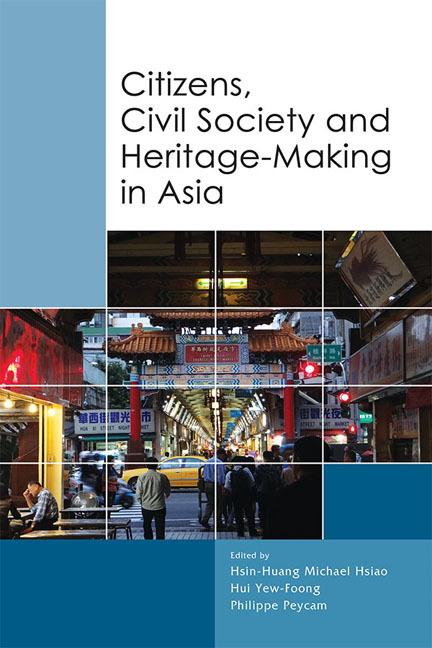Book contents
- Frontmatter
- Contents
- Contributors
- 1 Introduction: Finding the Grain of Heritage Politics
- 2 Heritage, Identity and Power
- 3 Heritage-Making and Post-coloniality in Yangon, Myanmar
- 4 Living Heritage of Ruins? Contesting the Paradox in Trowulan's Majapahit Heritage
- 5 The Reconstruction of Heritage in Rural Vietnam: An Analysis of State and Local Dynamics
- 6 Performing Cultures, Negotiating Identities: The Cultural Politics of Indigenous Cultural Villages in West Malaysia
- 7 Constituting Philippine Filmic and Linguistic Heritage: The Case of Filipino Regional Films
- 8 Encounter and Counter-Narratives of Heritage in Macau
- 9 Cultural Activities of the Chinese Community in Post-war Myanmar
- 10 Chinese Street Opera in Singapore: Heritage or a Vanishing Trade
- 11 Policy Formation and Civil Society Engagement in Heritage-Making in Taiwan: A Historical Examination
- 12 Becoming Taiwanese: Appropriation of Japanese Colonial Sites and Structures in Cultural Heritage-Making — A Case Study on the Wushantou Reservoir and Hatta Yoichi
- 13 Defining Culture in the Heritage Preservation of Taiwanese Veterans’ Villages: The Case of Zuoying
- 14 Tobacco Crop Memories in Taiwan: The Heritage of a Deadly Agriculture
- Index
7 - Constituting Philippine Filmic and Linguistic Heritage: The Case of Filipino Regional Films
Published online by Cambridge University Press: 03 January 2018
- Frontmatter
- Contents
- Contributors
- 1 Introduction: Finding the Grain of Heritage Politics
- 2 Heritage, Identity and Power
- 3 Heritage-Making and Post-coloniality in Yangon, Myanmar
- 4 Living Heritage of Ruins? Contesting the Paradox in Trowulan's Majapahit Heritage
- 5 The Reconstruction of Heritage in Rural Vietnam: An Analysis of State and Local Dynamics
- 6 Performing Cultures, Negotiating Identities: The Cultural Politics of Indigenous Cultural Villages in West Malaysia
- 7 Constituting Philippine Filmic and Linguistic Heritage: The Case of Filipino Regional Films
- 8 Encounter and Counter-Narratives of Heritage in Macau
- 9 Cultural Activities of the Chinese Community in Post-war Myanmar
- 10 Chinese Street Opera in Singapore: Heritage or a Vanishing Trade
- 11 Policy Formation and Civil Society Engagement in Heritage-Making in Taiwan: A Historical Examination
- 12 Becoming Taiwanese: Appropriation of Japanese Colonial Sites and Structures in Cultural Heritage-Making — A Case Study on the Wushantou Reservoir and Hatta Yoichi
- 13 Defining Culture in the Heritage Preservation of Taiwanese Veterans’ Villages: The Case of Zuoying
- 14 Tobacco Crop Memories in Taiwan: The Heritage of a Deadly Agriculture
- Index
Summary
Heritage-making is, more often than not, a task taken by the national government to bind its peoples and to make them recognize representations of national history, culture and identity. In this case the state becomes a source of what Laurajane Smith calls the “Authorized Heritage Discourse or AHD”, where heritage is seen as “nationally significant” (2014b). In this instance heritage-making entails processes that at times homogenize naturally diverse cultures; at times impose a national character to tangible and non-tangible artefacts that may not necessarily represent something meaningful to some people in other parts of the country. This practice of heritage-making invokes a collective experience, a shared culture that erases differences within the nation-state. In its recognition of what is a “national heritage”, it misrecognizes others’ heritage in the periphery. This is especially problematic in the context of the Philippines, an archipelagic country composed of 7,107 islands populated by various ethnic groups, and that makes processes of nation-formation complicated. The diversity of the country's cultures challenges the homogenized notion of a “national culture” and “national heritage” that the state espouses in its cultural policies.
A clear example of this cultural politics in the Philippines is the declaration of Filipino as the official language, a language that is primarily based in a regional language called Tagalog. This is despite the fact that 183 languages exist in the country that includes other major regional languages like Cebuano spoken widely in the Visayas and Mindanao islands, Ilocano in northern Luzon, Kapampangan in central Luzon, Hiligaynon in Panay and Negros islands, Bicol in Southern Luzon, and Waray in Samar and Leyte islands, among others. The said islands are among the largest and most populous in the Philippines. On the other hand, Tagalog is widely spoken in Manila, the capital city, and other nearby provinces and islands in Luzon.
When Tagalog was declared as the basis for the national language in 1937, the country was a commonwealth under the United States but essentially still a colony. Prior to this, in 1934, a Constitutional Convention was called to formulate the constitution for the commonwealth government to prepare for the colony's self-governance, which was to begin in 1935.
- Type
- Chapter
- Information
- Citizens, Civil Society and Heritage-Making in Asia , pp. 137 - 163Publisher: ISEAS–Yusof Ishak InstitutePrint publication year: 2017

